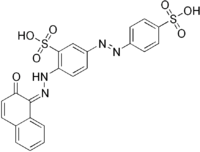This is the current revision of this page, as edited by Marbletan (talk | contribs) at 18:42, 12 December 2024. The present address (URL) is a permanent link to this version.
Revision as of 18:42, 12 December 2024 by Marbletan (talk | contribs)(diff) ← Previous revision | Latest revision (diff) | Newer revision → (diff)
| |
| Names | |
|---|---|
| IUPAC name 2--5-(4-sulfophenyl)diazenyl-benzenesulfonic acid | |
| Other names Croceine scarlet; C.I. 26905 | |
| Identifiers | |
| CAS Number |
|
| 3D model (JSmol) |
|
| ChemSpider | |
| ECHA InfoCard | 100.021.895 |
| EC Number |
|
| MeSH | Biebrich+scarlet |
| PubChem CID | |
| CompTox Dashboard (EPA) | |
InChI
| |
SMILES
| |
| Properties | |
| Chemical formula | C22H16N4O7S2 |
| Molar mass | 512.51 g·mol |
| Hazards | |
| GHS labelling: | |
| Pictograms | 
|
| Signal word | Warning |
| Hazard statements | H302, H312, H315, H319, H332, H335 |
| Except where otherwise noted, data are given for materials in their standard state (at 25 °C , 100 kPa).
| |
Biebrich scarlet (C.I. 26905) is a molecule used in Lillie's trichrome. It is an anionic mono-azo dye, which is an important pigmenting agent in the textile and paper industries, used to color wool, silk, cotton, and papers. The dye was created in 1878 by the German chemist Rudolf Nietzki. He was employed by Kalle & Co. and completed his contributions on August of 1880, where he claimed to be the inventor of Biebrich scarlet. The name, Biebrich scarlet, originated from the location where a company, Kalle & Co., marketed the dye in Biebrich (Wiesbaden).
Properties
Biebrich scarlet has two alternative structures: the keto form, with the IUPAC name of 2--5-benzene-1-sulfonate, and the enol form, with the IUPAC name of 2--5-benzene-1-sulfonic acid. The dye has the molecular weight formula of C22H16N4Na2O7S2, molecular weight of 512.52 grams per mol, and has the maximum absorption of 510 nm.
Environmental impacts and applications
Biebrich scarlet dyes are used to color hydrophobic materials like fats and oils. It's also one of the most often used dyes for plasma staining. The dye is an illegal dye for food additives because of its carcinogenic properties. Biebrich scarlet can have harmful effects on living and non-living organisms in natural water. This dye is strongly pigmented, and its presence in water bodies, even at low quantities (10-50 mg/L), can be detected, reducing the transparency of the water ecosystem. It also hinders the entry of sunlight into the water, affecting both zooplankton and phytoplankton in the water ecosystem, therefore the pollutant must be removed. Removal of the pollutant involves absorption, membrane filtration, precipitation, ozonation, fungal detachment, and electrochemical separation. Hydrogel absorbents have active sites to which the dye is held using electrostatic interactions. Photocatalysis allows for almost total degradation of Biebrich scarlet azo dye bonds in less than 10 hours. Degradation of Biebrich scarlet is also observed using lignin peroxidase enzyme from wood rotting fungus in the presence of mediators like 2-chloro-1,4-dimethoxybenzene.
With such a significant impact on the environment and surrounding resources, researchers are working to reduce the dye's presence in water bodies. Studies have shown techniques to remove the red dye Biebrich Scarlet (BS) from water using UV light and nanophotocatalysts like TiO₂, ZnO, CdS, and ZnS. Among these, ZnO performed the best in dye removal. To enhance the process, researchers adjusted factors such as catalyst concentration (0.25-1.25 g/L), solution pH (3-11), and dye concentration (5-100 mg/L). Precipitation was used to form the ZnO nanoparticles, which were then studied utilizing advanced technologies (XRD, FT-IR, TGA, SEM, and TEM) to confirm their characteristics. Experiments revealed that, under optimal conditions, these produced ZnO particles beat commercial ZnO powders in dye breakdown. Furthermore, the study found that the produced ZnO could be reused well, making it a suitable material for water treatment applications.
See also
References
- Lillie, R. D. (1940). "Further Experiments with the Masson Trichrome Modification of Mallory's Connective Tissue Stain". Stain Technology. 15 (1): 17–22. doi:10.3109/10520294009110327.
- Schwarz, Holm-Dietmar (1999). "Nietzki, Rudolf Hugo". Neue Deutsche Biographie (in German). Vol. 19. Retrieved 2015-10-12.
- ^ Cooksey, C. (2020). Quirks of dye nomenclature. 13. Biebrich scarlet. Biotechnic & Histochemistry, 95(3), 194–197. https://doi.org/10.1080/10520295.2019.1662945
- Bose, S., & Genwa, K. R. (2018). Fabrication of DSSCs with biebrich scarlet, alizarine cyanine green and evans blue dyes as new organic photosensitizers. Materials Science Poland, 36(4), 655–661. https://doi.org/10.2478/msp-2018-0077
- ^ Priya; Sharma, Amit Kumar; Kaith, Balbir Singh; et al. (2020). "Chemically modified chitosan‑sodium alginate as chemo-sensor adsorbent for the detection of picric acid and removal of biebrich scarlet". International Journal of Biological Macromolecules. 147: 582–594. doi:10.1016/j.ijbiomac.2020.01.090. PMID 31945433. S2CID 210699599.
- ^ Begum, Shamima; Mishra, Soumya Ranjan; Ahmaruzzaman, Md. (December 2022). "Fabrication of ZnO–SnO2 nanocomposite and its photocatalytic activity for enhanced degradation of Biebrich scarlet". Environmental Science and Pollution Research. 29 (58): 87347–87360. doi:10.1007/s11356-022-21851-1. ISSN 0944-1344.
- Kátia M. G. Machado, Dácio R. Matheus, and Vera L. R. Bononi (2005). "Ligninolytic enzymes production and Remazol brilliant blue R decolorization by tropical brazilian basidiomycetes fungi". Braz. J. Microbiol. 36 (3). doi:10.1590/S1517-83822005000300008.
{{cite journal}}: CS1 maint: multiple names: authors list (link) - Chebli, D.; Fourcade, F.; Brosillon, S.; et al. (12 January 2010). "Supported photocatalysis as a pre-treatment prior to biological degradation for the removal of some dyes from aqueous solutions; Acid Red 183, Biebrich Scarlet, Methyl Red Sodium Salt, Orange II". Journal of Chemical Technology & Biotechnology. doi:10.1002/jctb.2342.
- Cooksey, C J (2019-10-08). "Quirks of dye nomenclature. 13. Biebrich scarlet". Biotechnic & Histochemistry. 95 (3). Taylor & Francis: 194–197. doi:10.1080/10520295.2019.1662945. ISSN 1052-0295. LCCN 91641272. OCLC 8270589858. PMID 31592687.
- Kansal, Sushil Kumar; Hassan Ali, Ahmed; Kapoor, Seema (2010-09-15). "Photocatalytic decolorization of biebrich scarlet dye in aqueous phase using different nanophotocatalysts". Desalination. 259 (1): 147–155. doi:10.1016/j.desal.2010.04.017. ISSN 0011-9164.